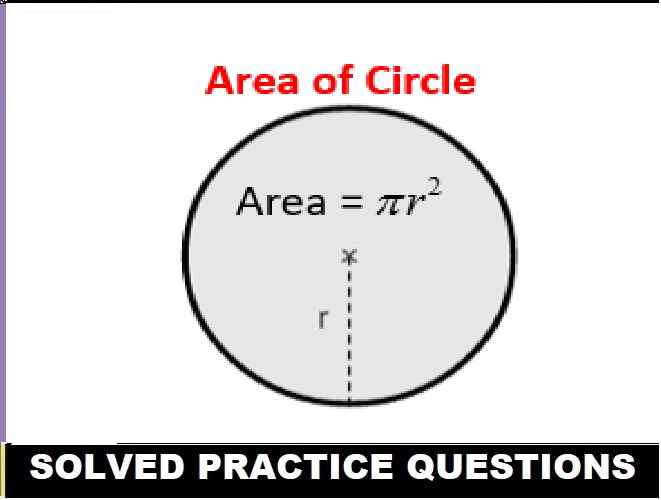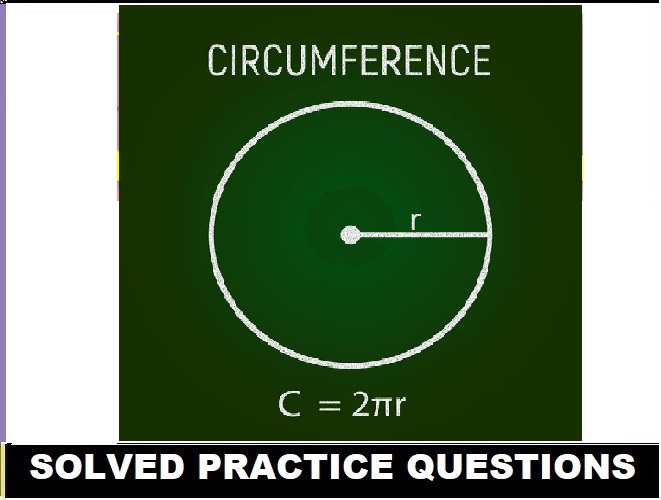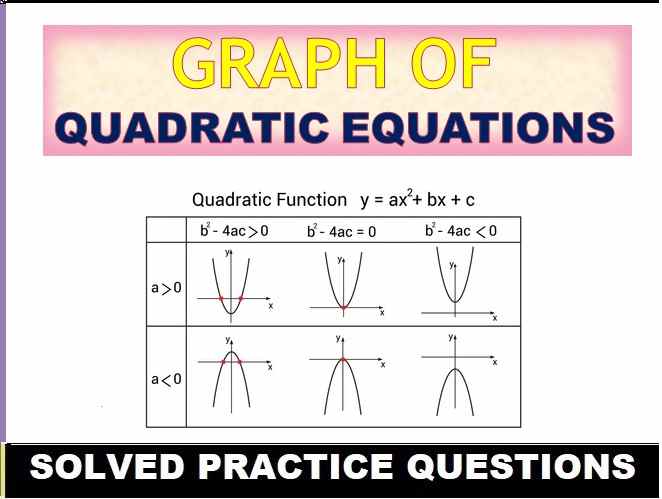ML Aggarwal Theorems on Area Exe-14 Class 9 ICSE Maths Solutions Ch-14. Step by Step Solutions of Questions on Theorems on Area of ML Aggarwal for ICSE Class 9th Mathematics. Visit official website CISCE for detail information about ICSE Board Class-9.
ML Aggarwal Theorems on Area Exe-14 Class 9 ICSE Maths Solutions Ch-14
| Board | ICSE |
| Subject | Maths |
| Class | 9th |
| Chapter-14 | Theorems on Area |
| Topics | Solution of Exe-14 Questions |
| Academic Session | 2024-2025 |
Solutions of Theorems on Area Questions
ML Aggarwal Theorems on Area Exe-14 Class 9 ICSE Maths Solutions
Question 1. Prove that the line segment joining the mid-points of a pair of opposite sides of a parallelogram divides it into two equal parallelograms.
Answer : ABCD be a parallelogram in which E and F are mid-points of AB and CD. Join EF.
Prove: ar (|| AEFD) = ar (|| EBCF)
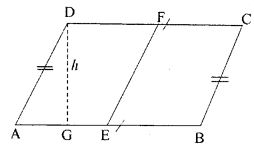
Let us construct DG ⊥ AG and let DG = h where, h is the altitude on side AB.
Proof: ar (|| ABCD) = AB × h
ar (|| AEFD) = AE × h
= ½ AB × h …(1) [Since, E is the mid-point of AB]
ar (|| EBCF) = EF × h
= ½ AB × h …(2) [Since, E is the mid-point of AB]
From (1) and (2)
ar (|| ABFD) = ar (|| EBCF)
Hence, proved.
Question 2. Prove that the diagonals of a parallelogram divide it into four triangles of equal area.
Answer : a parallelogram ABCD the diagonals AC and BD are cut at point O.
To prove: ar (∆AOB) = ar (∆BOC) = ar (∆COD) = ar (∆AOD)
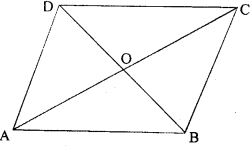
Proof: In parallelogram ABCD the diagonals bisect each other.
AO = OC
In ∆ACD, O is the mid-point of AC. DO is the median.
ar (∆AOD) = ar (COD) …(1) [Median of ∆ divides it into two triangles of equal areas]
ar (∆AOB) = ar (∆COB) …(2)
In ∆ADB,
ar (∆AOD) = ar (∆AOB) …(3)
In ∆CDB
ar (∆COD) = ar (∆COB) …(4)
From (1), (2), (3) and (4)
ar (∆AOB) = ar (∆BOC) = ar (∆COD) = ar (∆AOD)
Hence proved.
Question 3. (a) In the figure (1) given below, AD is median of ∆ABC and P is any point on AD. Prove that
(i) area of ∆PBD = area of ∆PDC.
(ii) area of ∆ABP = area of ∆ACP.
(b) In the figure (2) given below, DE || BC. prove that (i) area of ∆ACD = area of ∆ ABE.
(ii) area of ∆OBD = area of ∆OCE.
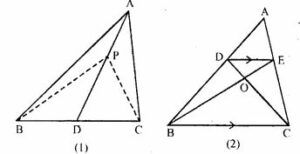
Answer :
(a) Given: ∆ABC in which AD is the median. P is any point on AD. Join PB and PC.
Prove: (i) Area of ∆PBD = area of ∆PDC.
(ii) Area of ∆ABP = area of ∆ACP.
Proof: From fig (1)
So, ar (∆ABD) = ar (∆ADC) …(1)
Also, PD is the median of ∆BPD
Similarly, ar (∆PBD) = ar (∆PDC) …(2)
Now, let us subtract (2) from (1), we get
ar (∆ABD) – ar (∆PBD) = ar (∆ADC) – ar (∆PDC)
Or, ar (∆ABP) = ar (∆ACP)
Hence proved.
(b) Given: ∆ABC in which DE || BC
Prove: (i) area of ∆ACD = area of ∆ ABE.
(ii) Area of ∆OBD = area of ∆OCE.
Proof: From fig (2)
∆DEC and ∆BDE are on the same base DE and between the same || line DE and BE.
ar (∆DEC) = ar (∆BDE)
Now add ar (ADE) on both sides, we get
ar (∆DEC) + ar (∆ADE) = ar (∆BDE) + ar (∆ADE)
⇒ ar (∆ACD) = ar (∆ABE)
Hence proved.
Similarly, ar (∆DEC) = ar (∆BDE)
Subtract ar (∆DOE) from both sides, we get
ar (∆DEC) – ar (∆DOE) = ar (∆BDE) – ar (∆DOE)
⇒ ar (∆OBD) = ar (∆OCE)
Question 4. (a) In the figure (1) given below, ABCD is a parallelogram and P is any point in BC. Prove that: Area of ∆ABP + area of ∆DPC = Area of ∆APD. (b) In the figure (2) given below, O is any point inside a parallelogram ABCD. Prove that:
(i) area of ∆OAB + area of ∆OCD = area of || gm ABCD.
(ii) area of ∆ OBC + area of ∆ AD = area of ||gm ABCD
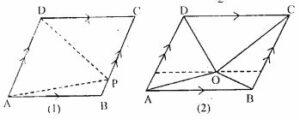
Answer : (a) Given: From fig (1)
ABCD is a parallelogram and P is any point in BC.
Prove: Area of ∆ABP + area of ∆DPC = Area of ∆APD
Proof: ∆APD and || gm ABCD are on the same base AD and between the same || lines AD and BC,
ar (∆APD) = ½ ar (|| gm ABCD) …(1)
In parallelogram ABCD
ar(|| gm ABCD) = ar (∆ ABP) + ar (∆APD) + ar (∆DPC)
Now, divide both sides by 2, we get
½ ar(|| gm ABCD) = ½ ar (∆ ABP) + ½ ar (∆APD) + ½ ar (∆DPC) …(2)
From (1) and (2)
ar (∆APD) = ½ ar (|| gm ABCD)
ar (∆APD) = ½ ar (∆ ABP) + ½ ar (∆APD) + ½ ar (∆DPC)
⇒ ar (∆APD) – ½ ar (∆APD) = ½ ar (∆ ABP) + ½ ar (∆DPC)
⇒ ½ ar (∆APD) = ½ [ar (∆ ABP) + ar (∆DPC)]
⇒ ar (∆APD) = ar (∆ ABP) + ar (∆DPC)
Or, ar (∆ ABP) + ar (∆DPC) = ar (∆APD)
Hence proved.
(b) Given: From fig (2)
|| gm ABCD in which O is any point inside it.
Prove: (i) area of ∆OAB + area of ∆OCD = ½ area of || gm ABCD
(ii) area of ∆ OBC + area of ∆ OAD = ½ area of || gm ABCD
Draw POQ || AB through O. It meets AD at P and BC at Q.
Proof: (i) AB || PQ and AP || BQ
ABQP is a || gm
Similarly, PQCD is a || gm
Now, ∆OAB and || gm ABQP are on same base AB and between same || lines AB and PQ
ar (∆OAB) = ½ ar (||gm ABQP) …(1)
ar (∆OCD) = ½ ar (||gm PQCD) …(2)
Now by adding (1) and (2)
ar (∆OAB) + ar (∆OCD) = ½ ar (|| gm ABQP) + ½ ar (|| gm PQCD)
= ½ [ar (|| gm ABQP) + ar (|| gm PQCD)]
= ½ ar (|| gm ABCD)
⇒ ar (∆OAB) + ar (∆OCD) = ½ ar (|| gm ABCD)
Hence proved.
(ii) we know that, ar (∆OAB) + ar (∆ OBC) + ar (∆OCD) + ar (∆OAD) = ar (|| gm ABCD)
⇒ [ar (∆OAB) + ar (∆OCD)] + [ar (∆ OBC) + ar (∆OAD)] = ar (|| gm ABCD)
⇒ ar (∆OBC) + ar (∆OAD) = ½ ar (|| gm ABCD)
Hence proved.
Question 5. If E, F, G and H are mid-points of the sides AB, BC, CD and DA respectively of a parallelogram ABCD, prove that area of quad. EFGH = 1/2 area of || gm ABCD.
Answer : In parallelogram ABCD, E, F, G, H are the mid-points of its sides AB, BC, CD and DA.
Join EF, FG, GH and HE.
Prove: area of quad. EFGH = ½ area of || gm ABCD
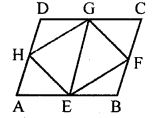
Proof: E and G are mid-points of AB and CD.
EG || AD || BC
AEGD and EBCG are parallelogram
Now, || gm AEGD and ∆EHG are on the same base and between the parallel lines.
ar ∆EHG = ½ ar || gm AEGD …(1)
Similarly,
ar ∆EFG = ½ ar || gm EBCG …(2)
Now by adding (1) and (2)
ar ∆EHG + ar ∆EFG = ½ ar || gm AEGD + ½ ar || gm EBCG
⇒ area quad. EFGH = ½ ar || gm ABCD
Hence proved.
Question 6
(a) In the figure (1) given below, ABCD is a parallelogram. P, Q are any two points on the sides AB and BC respectively. Prove that, area of ∆ CPD = area of ∆ AQD.
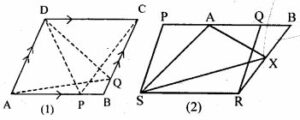
(b) In the figure (2) given below, PQRS and ABRS are parallelograms and X is any point on the side BR. Show that area of ∆ AXS = area of ||gm PQRS
Answer : (a) Given:
From fig (1) ||gm ABCD in which P is a point on AB and Q is a point on BC.
Prove: area of ∆ CPD = area of ∆ AQD.
Proof: ∆ CPD and ||gm ABCD are on the same base CD and between the same parallels AB and CD.
ar (∆ CPD) = ½ ar (||gm ABCD) …(1)
∆ AQD and ||gm ABCD are on the same base AD and between the same parallels AD and BC.
ar (∆AQD) = ½ ar (||gm ABCD) …(2)
from (1) and (2)
ar (∆ CPD) = ar (∆AQD)
Hence proved.
(b) From fig (2)
PQRS and ABRS are parallelograms on the same base SR. X is any point on the side BR.
Join AX and SX.
Prove: area of ∆ AXS = ½ area of ||gm PQRS
we know that, || gm PQRS and ABRS are on the same base SR and between the same parallels.
So, ar ||gm PQRS = ar ||gm ABRS …(1)
∆ AXS and || gm ABRS are on the same base AS and between the same parallels.
So, ar ∆ AXS = ½ ar ||gm ABRS
= ½ ar ||gm PQRS [From (1)]
Hence proved.
Question 7. D, E and F are mid-point of the sides BC, CA and AB respectively of a ∆ ABC. Prove that
(i) FDCE is a parallelogram
(ii) area of ADEF = area of A ABC
(iii) area of || gm FDCE = area of ∆ ABC.
Answer : D, E and F are mid-point of the sides BC, CA and AB respectively of a ∆ ABC.
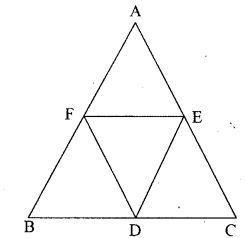
Prove: (i) FDCE is a parallelogram
(ii) area of ∆ DEF = ¼ area of ∆ ABC
(iii) area of || gm FDCE = ½ area of ∆ ABC
Proof: (i) F and E are mid-points of AB and AC.
So, FE || BC and FE = ½ BC …(1)
Also, D is mid-point of BC
CD = ½ BC …(2)
From (1) and (2)
FE || BC and FE = CD
⇒ FE || CD and FE = CD …(3)
D and F are mid-points of BC and AB.
So, DF || EC is a parallelogram.
Hence proved.
(ii) FDCE is a parallelogram.
And DE is a diagonal of ||gm FDCE
So, ar (∆ DEF) = ar (∆DEC) …(4)
Similarly, we know BDEF and DEAF are ||gm
So, ar (∆ DEF) = ar (∆ BDF) = ar (∆ AFE) …(5)
From (4) and (5)
ar (∆ DEF) = ar (∆DEC) = ar (∆ BDF) = ar (∆ AFE)
ar (∆ ABC) = ar (∆ DEF) + ar (∆ DEF) + ar (∆ DEF) + ar (∆ DEF)
= 4 ar (∆ DEF)
⇒ ar (∆ DEF) = ¼ ar (∆ ABC) …(6)
Hence proved.
(iii) ar of || gm FDCE = ar (∆ DEF) + ar (∆ DEC)
= ar (∆ DEF) + ar (∆ DEF)
= 2 ar (∆ DEF) [From (4)]
= 2 [¼ ar (∆ ABC)] [From (6)]
⇒ ar of || gm FDCE = ½ ar of ∆ ABC
Hence proved.
Question 8. In the given figure, D, E and F are mid points of the sides BC, CA and AB respectively of AABC. Prove that BCEF is a trapezium and area of trap. BCEF =  area of ∆ ABC.
area of ∆ ABC.
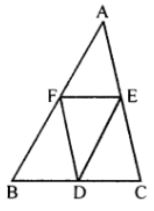
Answer : In ∆ABC, D, E and F are mid points of the sides BC, CA and AB.
Prove: area of trap. BCEF = ¾ area of ∆ ABC
Proof: D and E are the mid-points of BC and CA.
So, DE || AB and ½ AB
EF || BC and ½ BC
And FD || AC and ½ AC
∴ BDEF, CDFE, AFDE are parallelograms which are equal in area.
ED, DF, EF are diagonals of these ||gm which divides the corresponding parallelogram into two triangles equal in area.
Hence, BCEF is a trapezium.
area of trap. BCEF = ¾ area of ∆ ABC
Question 9.
(a) In the figure (1) given below, the point D divides the side BC of ∆ABC in the ratio m : n. Prove that area of ∆ ABD: area of ∆ ADC = m : n.
(b) In the figure (2) given below, P is a point on the side BC of ∆ABC such that PC = 2BP, and Q is a point on AP such that QA = 5 PQ, find area of ∆AQC : area of ∆ABC.
(c) In the figure (3) given below, AD is a median of ∆ABC and P is a point in AC such that area of ∆ADP : area of AABD = 2:3. Find
(i) AP : PC (ii) area of ∆PDC : area of ∆ABC.
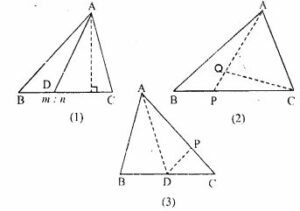
Answer : (a) From fig (1)
In ∆ABC, the point D divides the side BC in the ratio m: n.
BD: DC = m: n
Prove: area of ∆ ABD: area of ∆ ADC = m: n
Proof: area of ∆ ABD = ½ × base ×height
ar (∆ ABD) = ½ × BD ×AE …(1)
ar (∆ ACD) = ½ × DC ×AE …(2)
let us divide (1) by (2)
[ar(∆ABD) = ½×BD×AE]/[ar(∆ACD) = ½×DC×AE]
⇒ [ar (∆ ABD)]/[ar (∆ ACD)] = BD/DC
⇒ m/n [it is given that, BD: DC = m: n]
Hence proved.
(b) From fig (2)
In ∆ABC, P is a point on the side BC such that PC = 2BP, and Q is a point on AP such that QA = 5 PQ.
Find: area of ∆AQC: area of ∆ABC
Now, PC = 2BP
PC/2 = BP
BC = BP + PC
BC = BP + PC
= PC/2 + PC
= (PC + 2PC)/2
= 3PC/2
2BC/3 = PC
ar (∆APC) = 2/3 ar (∆ABC) …(1)
QA = 5PQ
QA/5 = PQ
QA= QA + PQ
So, QA = 5/6 AP
ar (∆AQC) = 5/6 ar (∆APC) = 5/6 (2/3 ar(∆ABC)) [From (1)]
⇒ ar (∆AQC) = 5/9 ar (∆ABC)
⇒ ar (∆AQC)/ ar (∆AQC) = 5/9
Hence proved.
(c) From fig (3)
AD is a median of ∆ABC and P is a point in AC such that area of ∆ADP: area of ∆ABD = 2:3
Find: (i) AP: PC
(ii) area of ∆PDC: area of ∆ABC
Now, (i) AD is the median of ∆ABC
ar (∆ABD) = ar (∆ADC) = ½ ar (∆ABC) …(1)
ar (∆ADP): ar (∆ABD) = 2: 3
AP: AC = 2: 3
AP/AC = 2/3
AP = 2/3 AC
Now, PC = AC – AP
= AC – 2/3 AC
= (3AC-2AC)/3
= AC/3 …(2)
So, AP/PC = (2/3 AC) / (AC/3)
= 2/1
AP: PC = 2:1
(ii) PC = AC/3
⇒ PC/AC = 1/3
ar (∆PDC)/ar (∆ADC) = PC/AC = 1/3
⇒ ar (∆PDC)/1/2 ar (∆ABC) = 1/3
⇒ ar (∆PDC)/ar (∆ABC) = 1/3 × ½ = 1/6
⇒ ar (∆PDC): ar (∆ABC) = 1: 6
Hence proved.
Question 10.
(a) In the figure (1) given below, area of parallelogram ABCD is 29 cm2. Calculate the height of parallelogram ABEF if AB = 5.8 cm
(b) In the figure (2) given below, area of ∆ABD is 24 sq. units. If AB = 8 units, find the height of ABC.
(c) In the figure (3) given below, E and F are mid points of sides AB and CD respectively of parallelogram ABCD. If the area of parallelogram ABC it is 36 cm².
(i) State the area of ∆ APD.
(ii) Name the parallelogram whose area is equal to the area of ∆ APD.
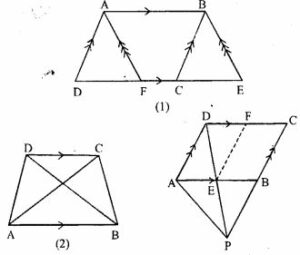
Answer :
(a) From fig (1)
ar ||gm ABCD = 29cm2
Find: Height of parallelogram ABEF if AB = 5.8 cm
||gm ABCD and ||gm ABEF with equal bases and between the same parallels so that there area are same.
ar (||gm ABEF) = ar (||gm ABCD)
⇒ ar (||gm ABEF) = 29cm2 …(1) [Since, ar ||gm ABCD = 29cm2]
also, ar (||gm ABEF = base × height)
29 = AB × height [From (1)]
⇒ 29 = 5.8 × height
⇒ Height = 29/5.8 = 5
∴ Height of parallelogram ABEF is 5cm
(b) From fig (2)
area of ∆ABD is 24 sq. units. AB = 8 units
Find: Height of ABC
ar ∆ABD = 24 sq. units …(1)
So, ar ∆ABD = ∆ABC …(2)
From (1) and (2)
ar ∆ABC = 24 sq. units
⇒ ½ × AB × height = 24
⇒ ½ × 8 × height = 24
⇒ 4 × height = 24
⇒ Height = 24/4 = 6
∴ Height of ∆ABC = 6 sq. units
(c) From fig (3)
In ||gm ABCD, E and F are mid points of sides AB and CD respectively.
ar (||gm ABCD) = 36cm2
Find: (i) State the area of ∆ APD.
(ii) Name the parallelogram whose area is equal to the area of ∆ APD.
(i) ∆ APD and ||gm ABCD are on the same base AD and between the same parallel lines AD and BC.
ar (∆ APD) = ½ ar (||gm ABCD) …(1)
⇒ ar (||gm ABCD) = 36cm2 …(2)
From (1) and (2)
ar (∆ APD) = ½ × 36 = 18 cm2
(ii) E and F are mid-points of AB and CD
In ∆CPD, EF || PC
Also, EF bisects the ||gm ABCD in two eual parts.
So, EF || AD and AE || DF
AEFD is a parallelogram.
ar (||gm AEFD) = ½ ar (||gm ABCD) …(3)
From (1) and (3)
ar (∆APD) = ar (||gm AEFD)
∴ AEFD is the required parallelogram which is equal to area of ∆APD.
Question 11.
(a) In the figure (1) given below, ABCD is a parallelogram. Points P and Q on BC trisect BC into three equal parts. Prove that :
area of ∆APQ = area of ∆DPQ = (1/6) (area of ||gm ABCD)
(b) In the figure (2) given below, DE is drawn parallel to the diagonal AC of the quadrilateral ABCD to meet BC produced at the point E. Prove that area of quad. ABCD = area of ∆ABE.
(c) In the figure (3) given below, ABCD is a parallelogram. O is any point on the diagonal AC of the parallelogram. Show that the area of ∆AOB is equal to the area of ∆AOD.
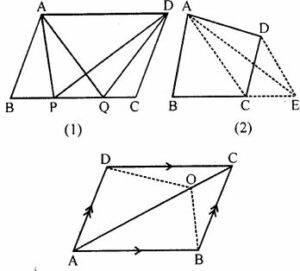
Answer : (a) Given: From fig (1)
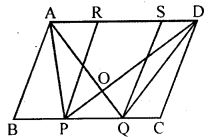
In ||gm ABCD, points P and Q trisect BC into three equal parts.
Prove: area of ∆APQ = area of ∆DPQ = 1/6 (area of ||gm ABCD)
Firstly, let us construct: through P and Q, draw PR and QS parallel to AB and CD.
Proof: ar (∆APD) = ar (∆AQD) [Since, ∆APD and ∆AQD lie on the same base AD and between the same parallel lines AD and BC]
⇒ ar (∆APD) – ar (∆AOD) = ar (∆AQD) – ar (∆AOD) [On subtracting ar ∆AOD on both sides]
⇒ ar (∆APO) = ar (∆OQD) ….. (1)
⇒ ar (∆APO) + ar (∆OPQ) = ar (∆OQD) + ar (∆OPQ) [On adding ar ∆OPQ on both sides]
⇒ ar (∆APQ) = ar (∆DPQ) …(2)
∆APQ and ||gm PQSR are on the same base PQ and between same parallel lines PQ and AD.
ar (∆APQ) = ½ ar (||gm PQRS) …(3)
[ar (||gm ABCD)/ar (||gm PQRS)] = [(BC×height)/(PQ×height)] = [(3PQ×height)/(1PQ×hight)]
⇒ ar (||gm PQRS) = 1/3 ar (||gm ABCD) …(4)
by using (2), (3), (4), we get
ar (∆APQ) = ar (∆DPQ)
= ½ ar (||gm PQRS)
= ½ × 1/3 ar (||gm ABCD)
= 1/6 ar (||gm ABCD)
Hence proved.
(b) Given: In the figure (2) given below, DE || AC the diagonal of the quadrilateral ABCD to meet at point E on producing BC. Join AC, AE.
Prove: area of quad. ABCD = area of ∆ABE
Proof: ∆ACE and ∆ADE are on the same base AC and between the same parallelogram.
ar (∆ACE) = ar (∆ADC)
Now by adding ar (∆ABC) on both sides, we get
ar (∆ACE) + ar (∆ABC) = ar (∆ADC) + ar (∆ABC)
⇒ ar (∆ ABE) = ar quad. ABCD
Hence, proved.
(c) Given: From fig (3)
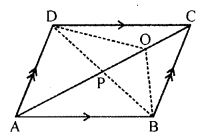
In ||gm ABCD, O is any point on diagonal AC.
Prove: area of ∆AOB is equal to the area of ∆AOD
Proof: Let us join BD which meets AC at P.
In ∆ABD, AP is the median.
ar (∆ABP) = ar (∆ADP) …(1)
ar (∆PBO) = ar (∆PDO) …(2)
Now add (1) and (2), we get
ar (∆ABO) = ar (∆ADO) …(3)
So, ∆AOB = ar ∆AOD
Hence proved.
Question 12.
(a) In the figure given, ABCD and AEFG are two parallelograms.
Prove that area of || gm ABCD = area of || gm AEFG.
(b) In the fig. (2) given below, the side AB of the parallelogram ABCD is produced to E. A st. line At through A is drawn parallel to CE to meet CB produced at F and parallelogram BFGE is Completed prove that area of || gm BFGE=Area of || gm ABCD.
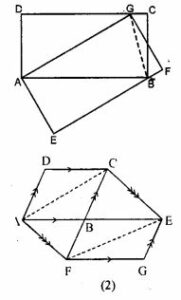
(c) In the figure (3) given below AB || DC || EF, AD || BE and DE || AF. Prove the area of DEFH is equal to the area of ABCD.
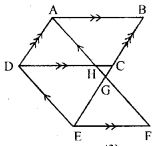
Answer : (a) From fig (1)
ABCD and AEFG are two parallelograms as shown in the figure.
Prove: area of || gm ABCD = area of || gm AEFG
Proof: let us join BG.
ar (∆ABG) = ½ (ar ||gm ABCD) …(1)
ar (∆ABG) = ½ (ar ||gm AEFG) …(2)
From (1) and (2)
½ (ar ||gm ABCD) = ½ (ar ||gm AEFG)
ar ||gm ABCD = ar ||gm AEFG)
Hence proved.
(b) From fig (2)
A parallelogram ABCD in which AB is produced to E. A straight line through A is drawn parallel to CE to meet CB produced at F and parallelogram BFGE is Completed.
Prove: area of || gm BFGE=Area of || gm ABCD
Proof: Let us join AC and EF.
ar (∆AFC) = ar (∆AFE) …(1)
Now, subtract ar (∆ABF) on both sides, we get
ar (∆AFC) – ar (∆ABF) = ar (∆AFE) – ar (∆ABF)
⇒ ar (∆ABC) = ar (∆BEF)
Now multiply by 2 on both sides, we get
2× ar (∆ABC) = 2× ar (∆BEF)
⇒ ar (||gm ABCD) = ar (||gm BFGE)
Hence proved.
(c) From fig (3)
AB || DC || EF, AD || BE and DE || AF
Prove: area of DEFH = area of ABCD
Proof: DE || AF and AD || BE
It is given that ADEG is a parallelogram.
ar (||gm ABCD) = ar (||gm ADEG) …(1)
Again, DEFG is a parallelogram.
ar (||gm DEFH) = ar (||gm ADEG) …(2)
From (1) and (2)
ar (||gm ABCD) = ar (||gm DEFH)
⇒ ar ABCD = ar DEFH
Hence proved.
Question 13. Any point D is taken on the side BC of, a ∆ ABC and AD is produced to E such that AD=DE, prove that area of ∆ BCE = area of ∆ ABC.
Answer : In ∆ABC, D is taken on the side BC.
AD produced to E such that AD = DE
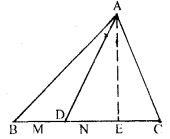
Prove: area of ∆ BCE = area of ∆ ABC
Proof: In ∆ABE, it is given that AD = DE
So, BD is the median of ∆ABE
ar (∆ABD) = ar (∆BED) …(1)
In ∆ACE, CD is the median of ∆ACE
ar (∆ACD) = ar (∆CED) …(2)
By adding (1) and (2), we get
ar (∆ABD) + ar (∆ACD) = ar (∆BED) + ar (∆CED)
⇒ ar (∆ABC) = ar (∆BCE)
Hence proved.
Question 14. ABCD is a rectangle and P is mid-point of AB. DP is produced to meet CB at Q. Prove that area of rectangle ∆BCD = area of ∆ DQC.
Answer : ABCD is a rectangle and P is mid-point of AB. DP is produced to meet CB at Q.
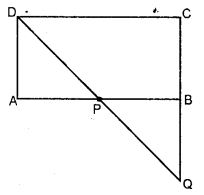
Prove: area of rectangle ∆BCD = area of ∆ DQC
Proof: In ∆APD and ∆BQP
AP = BP [Since, D is the mid-point of AB]
∠DAP = ∠QBP [each angle is 90o]
∠APD = ∠BPQ [vertically opposite angles]
So, ∆APD ≅ ∆BQP [By using ASA postulate]
ar (∆APD) = ar (∆BQP)
ar ABCD = ar (∆APD) + ar PBCD
= ar (∆BQP) + ar PBCD
= ar (∆DQC) Hence proved.
Question 15.
(a) In the figure (1) given below, the perimeter of parallelogram is 42 cm. Calculate the lengths of the sides of the parallelogram.
(b) In the figure (2) given below, the perimeter of ∆ ABC is 37 cm. If the lengths of the altitudes AM, BN and CL are 5x, 6x, and 4x respectively, Calculate the lengths of the sides of ∆ABC.
(c) In the fig. (3) given below, ABCD is a parallelogram. P is a point on DC such that area of ∆DAP = 25 cm² and area of ∆BCP = 15 cm². Find
(i) area of || gm ABCD
(ii) DP : PC.
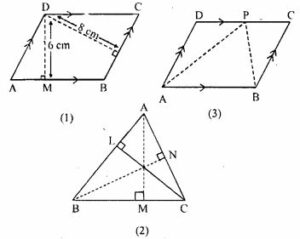
Answer : (a) The perimeter of parallelogram ABCD = 42 cm
Find: Lengths of the sides of the parallelogram ABCD.
From fig (1) AB = P
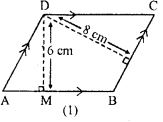
Then, perimeter of ||gm ABCD = 2 (AB + BC)
42 = 2(P + BC)
⇒ 21 = P + BC
⇒ BC = 21 – P
So, ar (||gm ABCD) = AB × DM
= P ×6
= 6P …(1)
Again, ar (||gm ABCD) = BC × DN
= (21 – P)× 8
= 8(21 – P) …(2)
From (1) and (2), we get
6P = 8(21 – P)
⇒ 6P = 168 – 8P
⇒ 6P + 8P = 168
⇒ 14P = 168
⇒ P = 168/14 = 12
Hence, sides of ||gm are
AB = 12cm and BC = (21 – 12)cm = 9cm
(b) The perimeter of ∆ ABC is 37 cm. The lengths of the altitudes AM, BN and CL are 5x, 6x, and 4x respectively.
Find: Lengths of the sides of ∆ABC. i.e., BC, CA and AB.
Let us consider BC = P and CA = Q
From fig (2),
Then, perimeter of ∆ABC = AB + BC + CA
37 = AB + P + Q
⇒ AB = 37 – P – Q
Area (∆ABC) = ½ × base × height
= ½ × BC × AM = ½ × CA × BN = ½ × AB × CL
= ½ × P × 5x = ½ × Q × 6x = ½ (37 – P – Q) × 4x
= 5P/2 = 3Q = 2(37 – P – Q)
5P/2 = 3Q
⇒ 5P = 6Q
⇒ 5P – 6Q = 0 …(1)
25P – 30Q (multiplying by 5)…(2)
3Q = 2(37 – P – Q)
⇒ 3Q = 74 – 2P – 2Q
⇒ 3Q + 2Q + 2P = 74
⇒ 2P + 5Q = 74 …(3)
⇒ 12P + 30Q = 444 (multiplying by 6)…(4)
By adding (2) and (4), we get
37P = 444
⇒ P = 444/37 = 12
Now, substitute the value of P in equation (1),
5P – 6Q = 0
⇒ 5(12) – 6Q = 0
⇒ 60 = 6Q
⇒ Q = 60/6 = 10
Hence, BC = P = 12cm
CA = Q = 10cm
And AB = 37 – P – Q = 37 – 12 – 10 = 15cm
(c) ABCD is a parallelogram. P is a point on DC such that area of ∆DAP = 25 cm² and area of ∆BCP = 15 cm².
Find: (i) area of || gm ABCD
(ii) DP: PC
Now let us find,
From fig (3)
(i) ar (∆APB) = ½ ar (||gm ABCD)
Then, ½ ar (||gm ABCD) = ar (∆DAP) + ar (∆BCP)
= 25 + 15
= 40cm2
So, ar (||gm ABCD) = 2×40 = 80cm2
(ii) ∆ADP and ∆BCP are on the same base CD and between same parallel lines CD and AB.
ar (∆DAP)/ar(∆BCP) = DP/PC
⇒ 25/15 = DP/PC
⇒ 5/3 = DP/PC
DP: PC = 5: 3
Question 16. In the adjoining figure, E is mid-point of the side AB of a triangle ABC and EBCF is a parallelogram. If the area of ∆ ABC is 25 sq. units, find the area of || gm EBCF.
Answer : EF, side of ||gm BCFE meets AC at G.
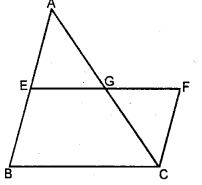
E is the mid-point and EF || BC
G is the mid-point of AC.
AG = GC
Now, in ∆AEG and ∆CFG,
The alternate angles are: ∠EAG, ∠GCF
Vertically opposite angles are: ∠EGA = ∠CGF
So, AG = GC, Proved.
∴ ∆AEG ≅ ∆CFG
ar (∆AEG) = ar (∆CFG)
ar (||gm EBCF) = ar BCGE + ar (∆CFG)
= ar BCGE + ar (∆AEG)
= ar (∆ABC)
ar (∆ABC) = 25sq. units
Hence, ar (||gm EBCF) = 25sq. units
Question 17.
(a) In the figure (1) given below, BC || AE and CD || BE. Prove that: area of ∆ABC= area of ∆EBD.
(b) In the llgure (2) given below, ABC is right angled triangle at A. AGFB is a square on the side AB and BCDE is a square on the hypotenuse BC. If AN ⊥ ED, prove that:
(i) ∆BCF ≅ ∆ ABE.
(ii) area of square ABFG = area of rectangle BENM.
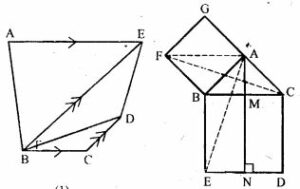
Answer : (a) From fig (1)
BC || AE and CD || BE
To prove:
area of ∆ABC= area of ∆EBD
Proof: By joining CE.
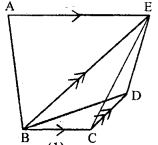
from ∆ABC and ∆EBC
ar (∆ABC) = ar (∆EBC) …(1)
From EBC and ∆EBD
ar (∆EBC) = ar (∆EBD) …(2)
From (1) and (2), we get
ar (∆ABC) = ar (∆EBD)
Hence, proved.
(b) ABC is right angled triangle at A. Squares AGFB and BCDE are drawn on the side AB and hypotenuse BC of ∆ABC. AN ⊥ ED which meets BC at M.
Prove: (i) ∆BCF ≅ ∆ ABE.
(ii) area of square ABFG = area of rectangle BENM
From the figure (2)
(i) ∠FBC = ∠FBA + ∠ABC
So, ∠FBC = 90o + ∠ABC …(1)
∠ABE = ∠EAC + ∠ABC
∠ABE = 90o + ∠ABC …(2)
From (1) and (2), we get
∠FBC = ∠ABE …(3)
So, BC = BE
Now, in ∆BCF and ∆ABE
BF = AB
By using SAS axiom rule of congruency,
∴ ∆BCF ≅ ∆ ABE Hence proved.
(ii) ∆BCF ≅ ∆ ABE
So, ar (∆BCF) = ar (∆ABE) …(4)
⇒ ∠BAG + ∠BAC = 90o + 90o = 180o
So, GAC is a straight line.
from ∆BCF and square AGFB
ar (∆BCF) = ½ ar (square AGFB) …(5)
From ∆ABE and rectangle BENM
ar (∆ABE) = ½ ar (rectangle BENM) …(6)
From (4), (5) and (6)
½ ar (square AGFB) = ½ ar (rectangle BENM)
ar (square AGFB) = ar (rectangle BENM)
Hence proved.
— : End of ML Aggarwal Theorems on Area Exe-14 Class 9 ICSE Maths Solutions :–
Return to :- ML Aggarawal Maths Solutions for ICSE Class-9
Thanks
Please Share with Your Friends
